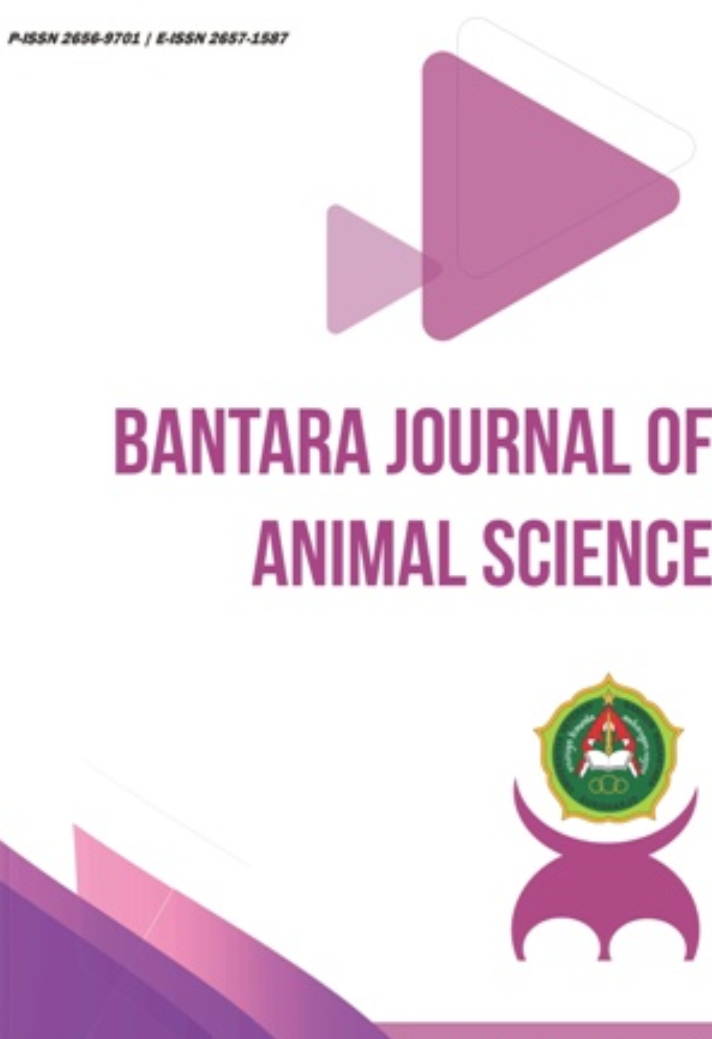Nutritional Content of Fermented Cassava (Manihot esculenta crantz) Peel Using Cattle Rumen Waste
DOI:
https://doi.org/10.32585/bjas.v6i1.5419Keywords:
Fermentation, Cassava Skin, Cow rumen wasteAbstract
This research aims to determine the effect of cow rumen waste on the nutritional value of cassava skin by increasing the values of dry matter content, crude fibre content and soluble protein content. This study used a unidirectional, completely randomized design (CRD) with four treatments and four replications. Then, the analysis was repeated two times. Fermentation was carried out for seven days. The treatment is P0 = 50 gram cassava peel + 14% bran + 2% molasses + 0% rumen waste, P1 = 50 gram cassava peel + 14% bran + 2% molasses + 2% rumen waste, P2 = 50 gram cassava peel + 14% rice bran + 2% molasses + 4% rumen waste, P3 = 50 gram cassava peel + 14% bran + 2% molasses + 6% rumen waste. The parameters observed in this study were the Dry Matter content (DW), Crude Fiber content (SK), and Soluble Protein content (PT). The results of measuring the dry matter content of P0, P1, P2 and P3 were achieved respectively, 33.92%, 38.88%, 43.20% and 51.20%. The crude fiber content results P0, P1, P2, P3 were achieved respectively at 0.41%, 0.72%, 1.16% and 1.49%. The results of dissolved protein levels P0, P1, P2 and P3 were achieved respectively at 5.11%, 5.17%, 5.73% and 7.20%. The research concluded that fermentation for seven days using cow rumen waste significantly affected the dry matter content, crude fibre content and soluble protein content of cassava peel.
Downloads
References
AOAC. 1980. Official Methods Of Analysis Of The Association Of Official Analytical Chemists. Riga Edition. PO BOX 540. Benjamin Franklin Station Washington DC 2004.
Central Bureau of Statistics. 2015. Harvest Area, Production and Productivity of Cassava and Sweet Potatoes.https://jateng.bps.go.idaccessed on August 13, 2022.
Haq, M., Shultana, F., Sylvia, M,, Danie, I, Y. 2018. Potential nutritional content of feed based on palm frond waste using fermentation techniques. Jurnal.umj.ac.id/index.pHp/semnastek. Accessed July 27, 2022.
Martono, Y., Lucia, D, D., Sri, H. 2016. Effect of Fermentation on Protein and Amino Acid Content in Cassava Flour Fortified with Soybean Flour (Glycine max (L)). Agritech, Vol. 36, no. 1.
Mulyono, A, M, W. 2010. Textbook: Experimental design. Kepel Press, Yogyakarta.
Muni, I, Y., Gusti, a, y., Lestari., Markus, M, K. 2021. Dry matter, organic matter and crude protein content of cassava peel resulting from EM4 fermentation with different doses. Journal of Dry Land Animal Husbandry. Volume 3 No. 2, 1390–1394 ISSN :2714-7878.
Nurlaili, F., Suparwi and Sutardi, TR 2013. Fermentation of cassava skin (Manihot utilissima pohl) using Aspergillus niger has an effect on dry matter digestibility (KcBK) and organic matter digestibility (KcBO) in-vitro. Animal Husbandry Scientific Journal. 1 (3) : 856 – 864.
Onweluzo, J, C., Nwabugwu, C, C. 2009. Fermentation of millet (Penisetum americannum) in pigeon pea (Cajanus cajan) seeds for flour production. Effect on composition and selected functional properties. Pakistan Journal Of Nutrition. 8 : 737 – 744.
Prasetya, A, A. 2020. The Effect of Rice Husk Fermentation Using Aspergillus niger on Dry Matter and Organic Matter Content. Script. Faculty of Agriculture, Veteran Bangun Nusantara University, Sukoharjo.
Ratnakomala, S. 2009. Saving Forage and Silage Forms. BioTrends. 4(1).
Sari, F, D, N., Astili, Rara. 2018. Original Article The Cyanide Acid Content of Jerky From Cassava Skin Waste The Level of Cyanide Acid in Cassava's Skinned Flaky. World Journal of Nutrition. Vol. 1, No. 1, 20-29. ISSN: 2614-6479.
Simbolon, N., Retno, I, P., Sri, M. 2016. The effect of various processing of cassava peel on the in vitro digestibility of dry matter and organic matter, crude protein and cyanide acid. Journal of Animal Science. 26 (1): 58 - 65 ISSN: 0852-3681 E-ISSN: 2443-0765.
Soejono, M. 1990. Laboratory Instructions for Feed Analysis and Evaluation. Faculty of Animal Husbandry, Gadjah Mada University. Yogyakarta.
Sudarmadji, S., Haryono, B and Suhardi. 1984. Analysis Procedures for Food and Agricultural Ingredients, Third Edition, Liberty, Yogyakarta.
Widodo J. 2014. Textbook of Internal Medicine. 4th ed. Setiati S, editor. Jakarta: Internal Publishing. 549 p.
Wilkinson, JM 1988. The Feed Value of Products and Wastes In: Food Science. Edited By : ER Orskov Rowett Research Institute d, Greenburn, Aberdeen Ab2 9 SB, Scotland.
Yunilas, L. Warly, Y. Marlida, and I. Riyanto. 2013. Potency of Indigenous Bacteria From Oil Palm Waste in Degrading Lignocelluse as a Sources of Inoculum Fermented to High Fiber Feed. Pakistan Journal of Nutrition 12 (9):851-853.
Downloads
Published
How to Cite
Issue
Section
License
Copyright (c) 2024 Hesti, Catur Suci Purwati, Engkus Ainul Yakin, Muhammad Husein

This work is licensed under a Creative Commons Attribution-NonCommercial-ShareAlike 4.0 International License.





